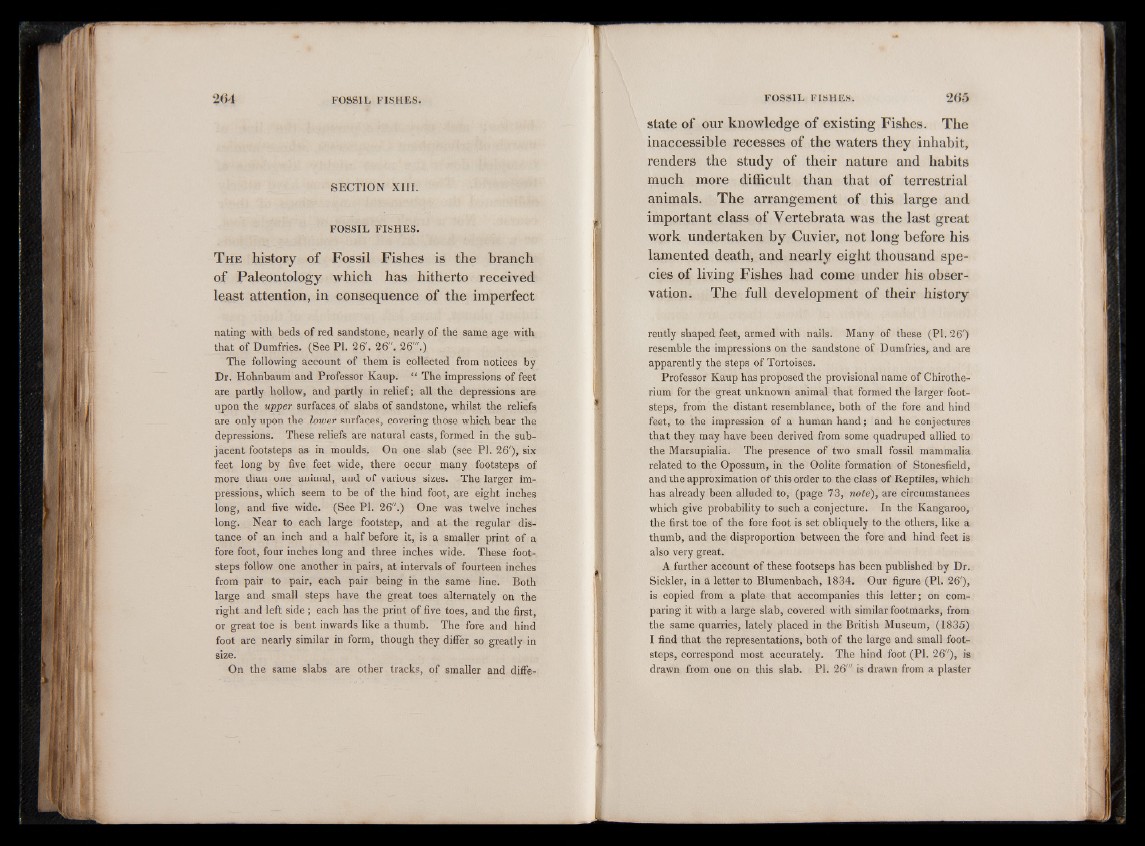
SECTION XIII.
FOSSIL FISHES.
T h e history of Fossil Fishes is the branch
of Paleontology which has hitherto received
least attention, in consequence of the imperfect
nating with beds of red sandstone, nearly of the same age with
that of Dumfries. (See PI. 26'. 26". 26"'.)
The following account of them is collected from notices by
Dr. Hohnbaum and Professor Kaup. “ The impressions of feet
are partly hollow, and partly in relief; all the depressions are
upon the upper surfaces of slabs of sandstone, whilst the reliefs
are only upon the lower surfaces, covering those which bear the
depressions. These reliefs are natural casts, formed in the subjacent
footsteps as in moulds. On one slab (see PI. 26'), six
feet long by five feet wide, there occur many footsteps of
more than one animal, and of various sizes. The larger impressions,
which seem to be of the hind foot, are eight inches
long, and five wide. (See PI. 26".) One was twelve inches
long. Near to each large footstep, and at the regular distance
of an inch and a half before it, is a smaller print of a
fore foot, four inches long and three inches wide. These footsteps
follow one another in pairs, at intervals of fourteen inches
from pair to pair, each pair being in the same line. Both
large and small steps have the great toes alternately on the
right and left side ; each has the print of five toes, and the first,
or great toe is bent inwards like a thumb. The fore and hind
foot are nearly similar in form, though they differ so greatly in
size.O
n the same slabs are other tracks, of smaller and diffestate
of our knowledge of existing Fishes. The
inaccessible recesses of the waters they inhabit,
renders the study of their nature and habits
much more difficult than that of terrestrial
animals. The arrangement of this large and
important class of Vertebrata was the last great
work undertaken by Cuvier, not long before his
lamented death, and nearly eight thousand species
of living Fishes had come under his observation.
The full development of their history
rently shaped feet, armed with nails. Many of these (PI. 26')
resemble the impressions on the sandstone of Dumfries, and are
apparently the steps of Tortoises.
Professor Kaup has proposed the provisional name of Chirothe-
rium for the great unknown animal that formed the larger footsteps,
from the distant resemblance, both of the fore and hind
feet, to the impression of a human hand; and he conjectures
that they may have been derived from some quadruped allied to
the Marsupialia. The presence of two small fossil mammalia
related to the Opossum, in the Oolite formation of Stonesfield,
and the approximation of this order to the class of Reptiles, which
has already been alluded to, (page 73, note), are circumstances
which give probability to such a conjecture. In the Kangaroo,
the first toe of the fore foot is set obliquely to the others, like a
thumb, and the disproportion between the fore and hind feet is
also very great.
A further account of these footseps has been published by Dr.
Sickler, in a letter to Blumenbach, 1834. Our figure (PI. 26'),
is copied from a plate that accompanies this letter; on comparing
it with a large slab, covered with similar footmarks, from
the same quarries, lately placed in the British Museum, (1835)
I find that the representations, both of the large and small footsteps,
correspond most accurately. The hind foot (PI. 26"), is
drawn from one on this slab. PI. 26"' is drawn from a plaster